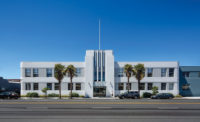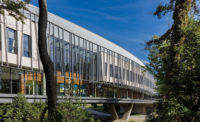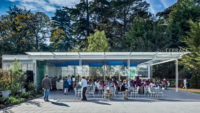About an hour and a half’s drive south of San Francisco, the University of California at Santa Cruz is a world apart, with its eclectic mid-rise buildings hidden among clusters of towering redwoods in the foothills of the Santa Cruz Mountains. However, its satellite Coastal Science Campus, on a windswept bluff along the Pacific Ocean a couple of miles away, called for a different architectural response. Designed by San Francisco–based firm EHDD, the new Coastal Biology Building, for research and teaching on coastal conservation, ecology, and climate change, reconciles a context-appropriate agricultural vernacular with modern lab requirements and the demand for collaborative spaces.
Additional Content:
Jump to credits & specifications
The two-story, 40,000-square-foot building brings together faculty, researchers, and grad students of the Ecology and Evolutionary Biology department, previously split between the main campus and an older building at the coast-side campus. It is designed to support 25 researchers and their teams of students, with 20 laboratories, 44 offices, and a specialized seawater research lab.
Because of the sensitive nature of the 98-acre campus, which encompasses a former Brussels sprouts field and a protected lagoon, the university commissioned a comprehensive land-use plan by BMS Design Group and EHDD, in preparation for a major expansion of its existing facilities. The location and size of the Coastal Biology building, along with future planned development, is strictly limited by the plan, which also incorporates an extensive stormwater drainage system of swales to preserve the seasonal bogginess of the marine terrace. In addition to their clients, the architects consulted the state’s Coastal Commission, which has jurisdiction over coastal development— and which asked for a gabled, barn-style structure to reflect the area’s history of farming. “Our goal was to embrace the agricultural form and make the building really simple and elegant,” says Scott Shell, a principal at EHDD. “The design isn’t necessarily breaking new ground so much as being super-respectful to the client and the task we were given.”
The biology building is EHDD’s second opportunity to affect the architectural tenor of the campus. Back in 1978, one of the firm’s founding partners, Chuck Davis, designed the first buildings there: two small one-story labs that are still in use today. With their pitched roofs and weathered wood siding, they appear to be simple sheds, but, in fact, contain a complex system for seawater research. In some ways, the new Coastal Biology Building is a throwback to Davis’s original labs, with a deliberately spare form and a rainscreen of Western red cedar that will weather naturally to gray. The familiar barn shape has been updated with operable steel-framed windows (the building has no air-conditioning), walls of glazing, and skylights for balanced daylighting.
To provide sheltered outdoor space for the researchers, the architects designed the building as an asymmetric “U” (with one long leg and one short one) around a courtyard to block the continuous coastal winds. The long leg of the building contains the labs and offices; the individual labs are stacked on the north side to allow for large windows while mitigating direct sunlight, and the offices face the south, with views of the ocean. To break up the mass of the lab/office wing, the architects inserted a glass stairwell volume that connects the two wood-clad segments. The building’s interiors are simply finished, with concrete floors, drywall, and acoustical metal decking (ductwork is hidden rather than exposed).
The short leg of the building contains the main seminar room, which opens on to the courtyard. Linking the two wings is the building lobby and ground-floor dissection classroom; above is a meeting room that overlooks the neighboring lagoon. The relatively narrow volumes of the courtyard building support a sense of connectivity to the surrounding environment. “It’s so nice to be here with all the windows, and to walk down the hallway and be able to say hi to professors, now that we’re all in the same building,” says Kate Cary, a doctoral candidate in ecology and evolutionary biology, who moved here from the main campus a year ago.
For improved energy efficiency (a priority for EHDD: it is one of a small handful of firms on track to reach a net zero portfolio by 2030), the architects employed a steel frame structure but opted for wood instead of steel studs for the walls to prevent thermal bridging and improve comfort. The seminar room, a large space for teaching and lectures, also uses a mix of structural materials, but for different reasons. “To keep the courtyard side of the room as light and transparent as possible, we continued the wood roof trusses down to the ground with wood columns,” says Shell. On the other side of the room, where the large presentation screens are mounted, steel columns discreetly handle all the shear stresses. Overhead, the bottom chords of the wood trusses are made of thin steel rods—a combination of materials that, like the larger building, speaks both of tradition and modernity.
CreditsArchitect: EHDD—Scott Shell, design principal; Ken Powelson, project manager; Jessica Lane, project architect; John Christiansen, director of construction administration
Engineering: Mar Structural Design; Cammisa & Wipf (electrical); Taylor Engineering (mechanical); GHD Engineering (civil)
General contractor: Swinerton Builders |
SpecificationsWood Cudahy Lumber Company
Metal panels Alucobond
Moisture barrier GCP Applied Technologies
Curtain wall, Metal frame windows, Entrances Kawneer
Glazing Vitro Architectural Glass, Oldcastle BuildingEnvelope, Wasco, 3form, Saint-Gobain
Paints and stains Benjamin Moore
Floor and wall tile Heath Ceramics
Flooring Mondo Contract Flooring, Nora, Interface
Office furniture Steelcase
Conveyance ThyssenKrupp
Acoustical panels Conwed Designscape |












Post a comment to this article
Report Abusive Comment